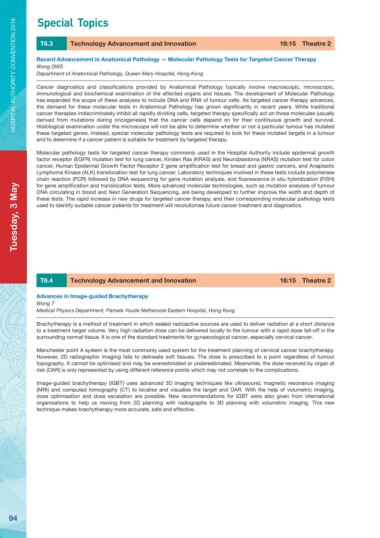Page 96 - HA Convention 2016 [Full Version]
P. 96
HOSPITAL AUTHORITY CONVENTION 2016 Special Topics
T6.3 Technology Advancement and Innovation 16:15 Theatre 2
Tuesday, 3 May Recent Advancement in Anatomical Pathology — Molecular Pathology Tests for Targeted Cancer Therapy
Wong DWS
Department of Anatomical Pathology, Queen Mary Hospital, Hong Kong
Cancer diagnostics and classifications provided by Anatomical Pathology typically involve macroscopic, microscopic,
immunological and biochemical examination of the affected organs and tissues. The development of Molecular Pathology
has expanded the scope of these analyses to include DNA and RNA of tumour cells. As targeted cancer therapy advances,
the demand for these molecular tests in Anatomical Pathology has grown significantly in recent years. While traditional
cancer therapies indiscriminately inhibit all rapidly dividing cells, targeted therapy specifically act on those molecules (usually
derived from mutations during oncogenesis) that the cancer cells depend on for their continuous growth and survival.
Histological examination under the microscope will not be able to determine whether or not a particular tumour has mutated
these targeted genes. Instead, special molecular pathology tests are required to look for these mutated targets in a tumour
and to determine if a cancer patient is suitable for treatment by targeted therapy.
Molecular pathology tests for targeted cancer therapy commonly used in the Hospital Authority include epidermal growth
factor receptor (EGFR) mutation test for lung cancer, Kirsten Ras (KRAS) and Neuroblastoma (NRAS) mutation test for colon
cancer, Human Epidermal Growth Factor Receptor 2 gene amplification test for breast and gastric cancers, and Anaplastic
Lymphoma Kinase (ALK) translocation test for lung cancer. Laboratory techniques involved in these tests include polymerase
chain reaction (PCR) followed by DNA sequencing for gene mutation analysis, and fluorescence in situ hybridization (FISH)
for gene amplification and translocation tests. More advanced molecular technologies, such as mutation analyses of tumour
DNA circulating in blood and Next Generation Sequencing, are being developed to further improve the width and depth of
these tests. The rapid increase in new drugs for targeted cancer therapy, and their corresponding molecular pathology tests
used to identify suitable cancer patients for treatment will revolutionise future cancer treatment and diagnostics.
T6.4 Technology Advancement and Innovation 16:15 Theatre 2
Advances in Image-guided Brachytherapy
Wong T
Medical Physics Department, Pamela Youde Nethersole Eastern Hospital, Hong Kong
Brachytherapy is a method of treatment in which sealed radioactive sources are used to deliver radiation at a short distance
to a treatment target volume. Very high radiation dose can be delivered locally to the tumour with a rapid dose fall-off in the
surrounding normal tissue. It is one of the standard treatments for gynaecological cancer, especially cervical cancer.
Manchester point A system is the most commonly used system for the treatment planning of cervical cancer brachytherapy.
However, 2D radiographic imaging fails to delineate soft tissues. The dose is prescribed to a point regardless of tumour
topography. It cannot be optimised and may be overestimated or underestimated. Meanwhile, the dose received by organ at
risk (OAR) is only represented by using different reference points which may not correlate to the complications.
Image-guided brachytherapy (IGBT) uses advanced 3D imaging techniques like ultrasound, magnetic resonance imaging
(MRI) and computed tomography (CT) to localise and visualise the target and OAR. With the help of volumetric imaging,
dose optimisation and dose escalation are possible. New recommendations for IGBT were also given from international
organisations to help us moving from 2D planning with radiographs to 3D planning with volumetric imaging. This new
technique makes brachytherapy more accurate, safe and effective.
94

